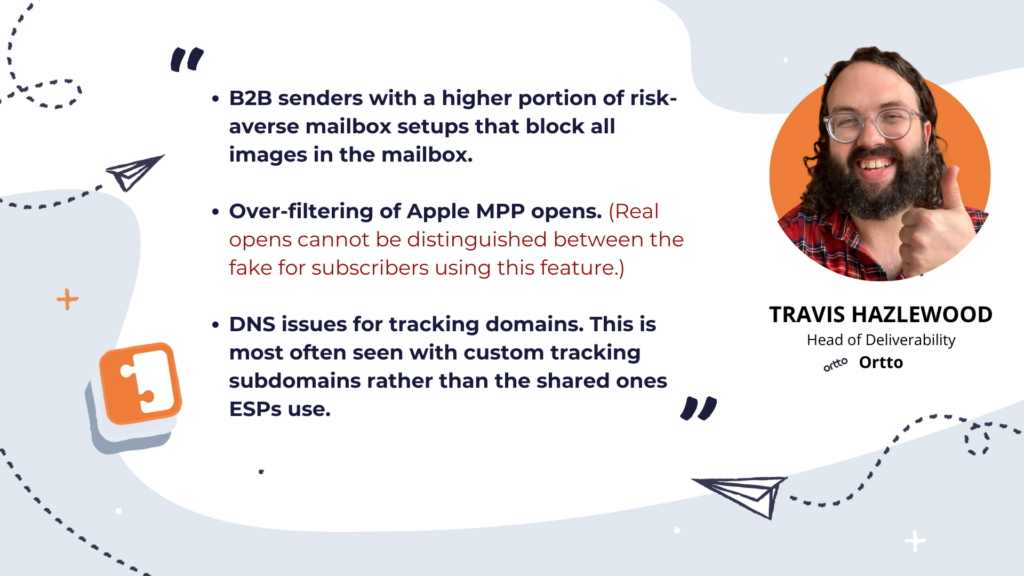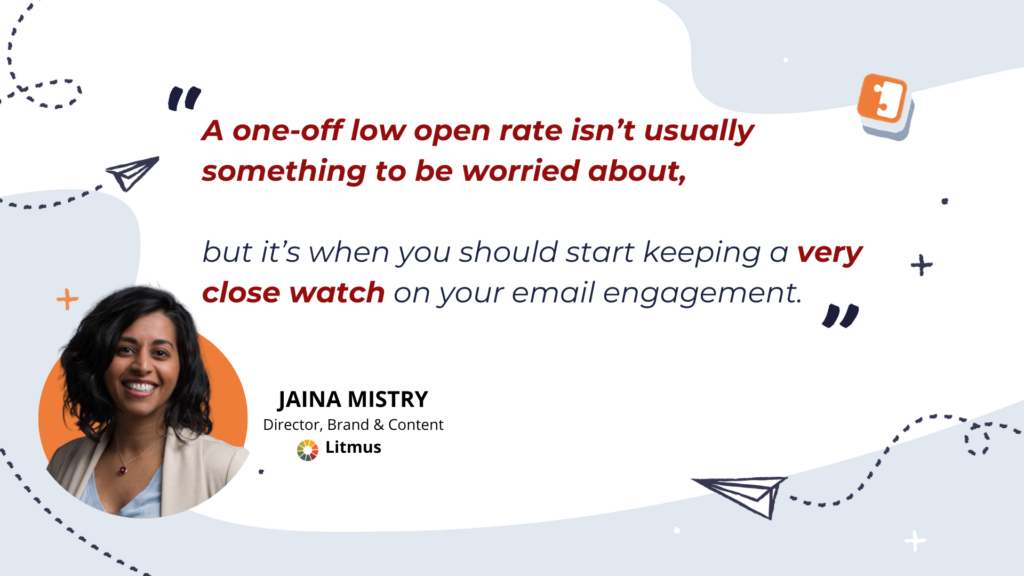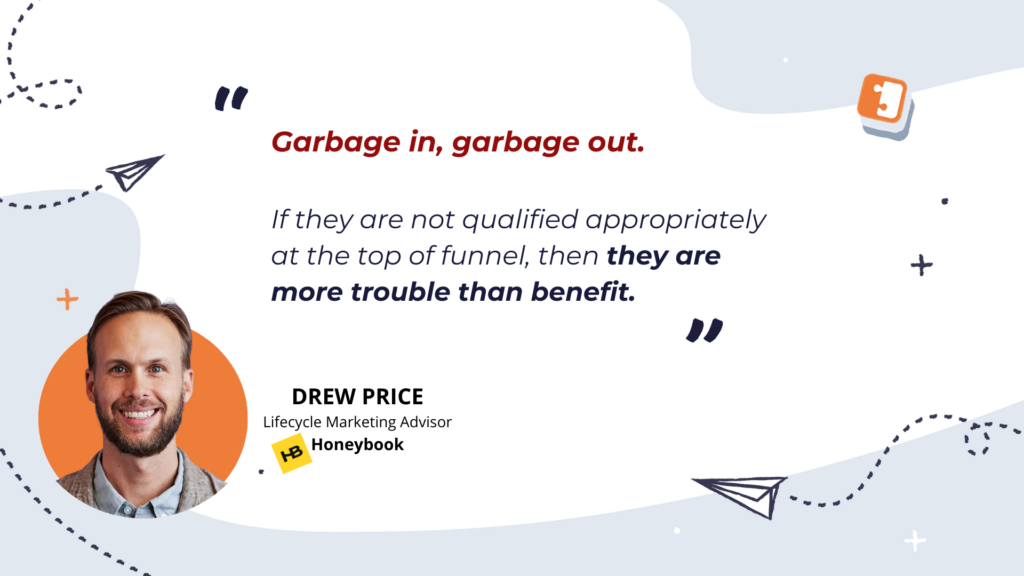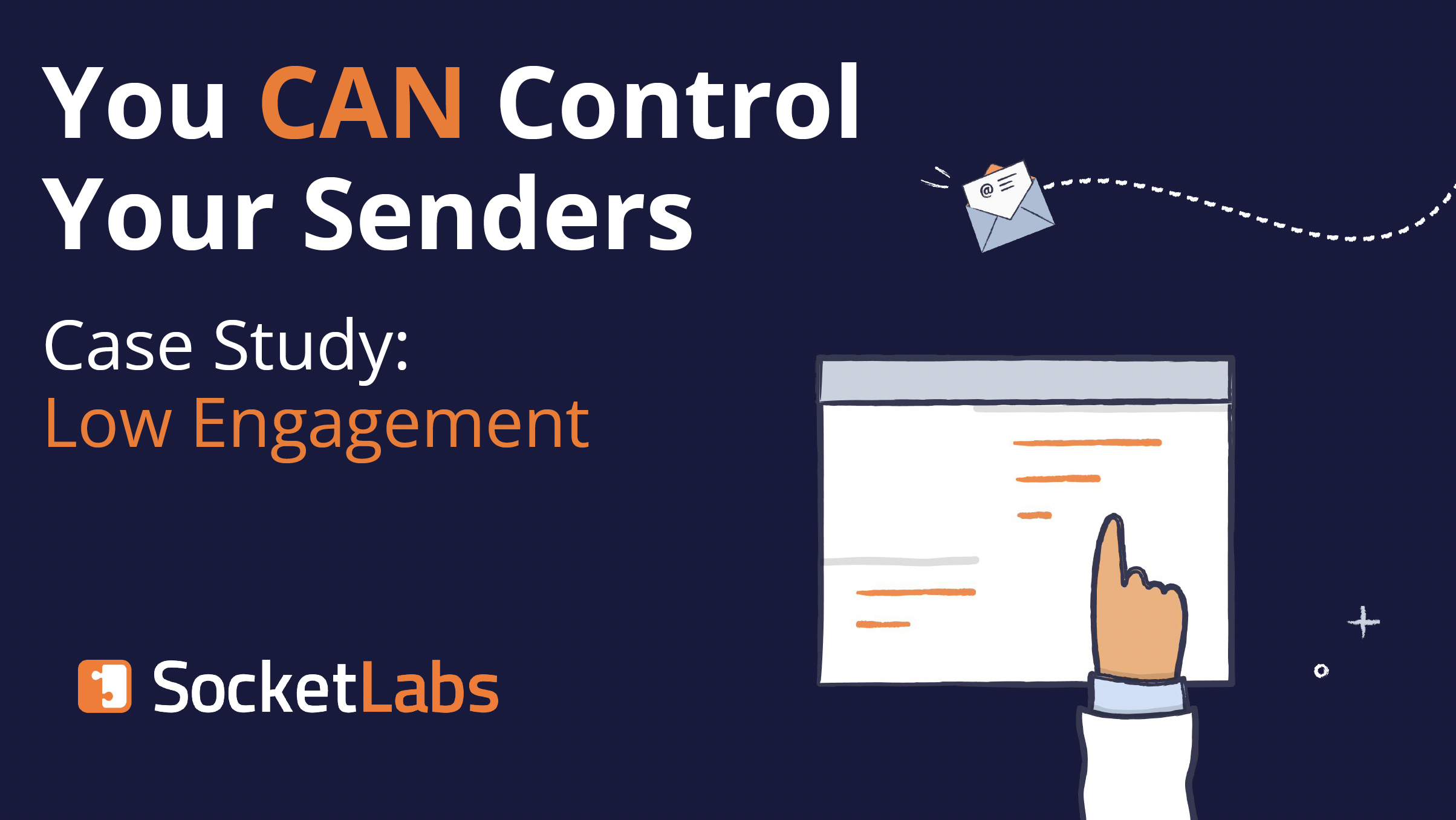
Hello again! Happy to see you here for our series, Email Performance Red Flags.
Last time, we discussed how unsubscribes impact email performance with industry experts Desislava Zhivkova, Skyler Holobach, and Autumn Tyr-Salvia. Is a high unsub rate an issue? Is it more worrisome than people marking your emails as spam? What do you do when yours is high? We’ve gotten the full download.
Before that, we dug into spam complaints, which are like poison for your email performance (and brand). It’s a must-read for anyone pushing “Send.”
But now…
Today’s Red Flags: Low Open Rates
Let’s talk about a very meaningful email performance red flag: low open rates. I know, I know, opens are problematic because they’re becoming less and less accurate over time. But they’re still a great metric to pay attention to for performance monitoring, trend analysis, and insights into what your email audience likes (and doesn’t).
We’ll look at why a low open rate is a red flag, what it means, and how to change that flag from red to green, thanks to help from guest experts who have years of experience with this exact problem.
Who are they?
Our Email Experts for Today
As always, let’s start with introductions!
Drew Price has spent more than 17 years in email and lifecycle marketing across tech, publishing, and retail. Most notably, he scaled Grammarly’s email channel from 0 to 3 billion emails per year from 2014 to 2020, and now he is a lifecycle marketing advisor at HoneyBook. If lifecycle and retention marketing is part of your focus, you should sign up for his weekly newsletter: Scaling CRM. I’m a huge fan!
Jaina Mistry is the director of brand and content marketing at email design tool behemoth Litmus, where she’s developed her skills over the last eight years. Prior to Litmus, Jaina built a vast and varied career in freelance writing, from email to blogs, and is a deeply knowledgeable source of best practices guidance.
Travis Hazlewood is writer and head of deliverability at Ortto, where he’s spent the last few years guiding their email practice to the best outcomes. He has more than five years of experience in email at large and has an extensive history doing some of the hardest work in deliverability…customer support! He’s a consistent blogger and has co-authored an ebook on deliverability, all with the intent to educate and support email senders in reaching their highest performance possible.
Now that you’re familiar with our email smarties for today, let’s get into it.
What’s an Open Rate?
The Googley bot is gonna tell you the open rate is a metric used by email marketers to measure the percentage of subscribers who open an email campaign. It’s calculated by dividing the number of unique opens by the total number of recipients and multiplying by 100.
In some instances, people might calculate their open rate based on the total number of emails they attempted to send but really, it’s ideal to focus on how many delivered emails were eventually opened…because you can’t open an email that got rejected at the front door. Stick with the stuff that had a chance of being opened.
(Note we won’t be popping any cans of worms about bounces today, but we will dig into them in a later edition of our Red Flags series.)
For now, let’s get back to opens.
What’s Considered “Low”?
This is an objective question because even within the same industry, answers will vary. Each organization has their own KPIs and goals, so they should also have their own set of benchmarks. “Your past self is your best competitor. Do better today than you did yesterday,” is something I’ve often said when folks ask about my favorite benchmark reports.
That said, we’re not going to leave you hanging.
“In general, I consider 20% the bottom side of average or OK. Anything below that is low,” reported Travis. “Open rates below 18% usually mean a low reputation or engagement rate is starting to grow serious. Anything under 15% is for sure unhealthy, and 12% or lower is a serious problem.”
This is on par with what I’d have said if you pinned me down for an answer, too. Although, as Jaina pointed out, “What you consider a low open rate will be dependent on what your average open rate usually is.”
…Which is why having a good sense of what your typical performance looks like is so helpful! 20% could be great for one of your competitors, but if it’s half as many people as typically open your mail, it makes 20% not just low, but a big, red flag waving in the wind.
Why Should I Worry About a Low Open Rate?
An email that doesn’t get opened isn’t likely to earn much revenue — unless, of course, your subject lines are so good, people to decide to skip reading your email and jump straight to your website to buy all of the things. If that’s your reality, good on you. But most of us are aiming for people to engage with our brands via email…working in unison with other communication channels to foster a relationship leading to trust. That’s much less likely to happen if they’re not opening.
It goes without saying, an unopened email means no email clicks, either. Bummer.
What’s more, a low open rate can begin to signal to mailbox providers (MBPs) your mail isn’t exactly wanted, expected, or appreciated by their users. Over time, if they notice mail from your domain is typically deleted without being opened or just sinks further and further down their inbox, you could find your deliverability — and email performance — starting to take a hit.
When Should I Worry About a Low Open Rate?
The answer to this question is very similar to the answer about what should be considered average or low: It depends. Go ahead, get your eye-rolls out. I just did, too. 🙄 It doesn’t make it any less true though.
“I have a sliding scale based on target audience volume, the nature of a program (cadence/KPI), and historical baselines,” explained Drew. “But generally speaking, I’d say below 15% at aggregate would be the danger zone and I’d only be OK going that low for something like a monthly promo program that’s targeting free users; for example, we don’t have third-party commercials or ads, but we do advertise our own products and we understand that’s not engaging to everyone on a regular basis.”
A good rule of thumb is to look at the trends in your open rates to establish your baseline. This will give you a better sense of what could be a fluke or environmental issue (like a busy email day where you got lost in the mix) versus what is either markedly lower than usual or lasts longer than a couple of sends.
“I would start feeling a little nervous about my open rate if I saw it drop by around 5 percentage points and it continues to drop over send after send—AND I haven’t made any radical changes to the cadence, volume, or content of the emails,” noted Jaina. “This does mean you should be tracking your open rate over time to be able to see that drop, but it’s a worthwhile metric to track to help you understand your email deliverability.
What Causes Low Open Rates?
How much time do you have? Just kidding, mostly.
We’ll try to keep it brief, though there are many reasons your open rate could be low. Here are the most common.
Cause #1: Poor List Quality
No shocker here. Do you have clean lists with highly engaged recipients, or do subscribers go silent on you as soon as they’ve grabbed their one-time discount code?
Everything from the lead magnets you’ve chosen, the expectations you’ve set, your ability to weed out problematic addresses (such as typos and bot signups) at the point of signup, and the way you manage your list over time all contribute to the quality of your list. Which, in turn, has a major impact on all your engagement metrics, especially opens.
A few major things to consider:
- Consent: Are they looking forward (or at least expecting) to hear from you? At the very least, you should make sure everyone on your list has freely provided their email address and given you permission to contact them. Without this, you’re reducing the chances that someone will engage positively with your emails (and brand) and increasing your chances of someone marking your email as spam, which is a huge risk to your deliverability. Choose quality over quantity every day of the week, my friend.
- List collection practices: When folks are giving you their email addresses, are you being clear about the kinds of communication you’ll provide? Are your lead magnets (like benefits for signing up) aligned with the content you’re about to start sending them? Make sure you’re being honest and upfront about what’s to come so you don’t find yourself sending email to folks who never open.
- List Hygiene: Are you periodically (or frequently) removing unengaged addresses from your list? The more unengaged email addresses you’re sending to, the lower your open rate will be.
Jaina shared the perfect way to end this section: “Above all, just say no to using rented or purchased lists. These will have the biggest impact on your open rate because you simply can’t trust the quality of the list no matter how many validation services you use to run that list through.”
Cause #2: Email Marketing Strategy
Also not shocking: your email strategy is another major component of your performance. The decisions you make directly impact your success, of course. There are a few obvious (and less-obvious) pitfalls to avoid.
- Frequency: Email fatigue is real. The humans you’re sending to are busy people, and if you’re sending too frequently and not delivering something they feel is worth their time, a low open rate could be a direct result. On the flip side, emailing them too infrequently can have a similar effect. They might not remember who you are or why they opted in for your mail in the first place.
- Segmentation: If you aren’t breaking your lists down into smaller chunks to make personalization easier and more effective, you could be falling into the “trying to be everything to everyone” trap. What happens then? You’re nothing to nobody!
- Content issues: There are strategic decisions to make with your content that beyond the actual purpose of the email. If your friendly From address is unrecognizable, your recipients might not feel comfortable opening the mail. Are you using enticing and clear subject lines? Are you adding preview text (sometimes referred to as “preheader text”) to add context? If you aren’t giving them enough information at a glance to convince them your email is worth their time, you could find yourself deleted or ignored rather than opened.
Want an example of a strategic misfire? Drew has one for us.
“I had a client recently who had an 18-day onboarding journey for free users and sent an upsell message every day for 18 days. Wishful thinking that people would tolerate this.”
I’ve seen this many times as well. One of the brands coming to mind insisted their mail deserved to reach the inbox…while sending twice daily to every email address that came in through their single opt-in form. They’d do this for a full 180 days before dropping the frequency. That’s 360 emails. With zero signs of life in six months. Then they’d only email them daily. How kind of them. Best case, recipients chose to ignore all of that mail; worst case, they were marking it as spam, putting yet another dent in their deliverability armor.
This is not the way.
Drew had one more piece of wisdom to share on this point: “Low open rates are almost always a symptom of other issues going on. Don’t blame the MBPs. They are on the customer’s side. And so should we all be.”
<chef’s kiss> to that, Drew.
Cause #3: Deliverability Issues
Naturally, after we’ve talked through how poor list quality and an email marketing strategy that’s gone haywire can cause low open rates, we need to address the potential cause and effect. If you send to people you shouldn’t, contact them too often, or deliver irrelevant content — and now you’re seeing low open rates — you may have a deliverability issue on your hands.
We’ll get into how to identify and investigate that in a bit.
Cause #4: Technical Problems
Technology isn’t perfect, although it certainly feels like it should be (come on already, you robots!). Truth is, some technical issues affecting your open rates are within your control while others are completely outside of your control.
The ones within your control, such as when a DNS entry is accidentally deleted due to a recent release by your dev team, can trigger providers like Microsoft, Google, and Yahoo to start temporarily deferring your mail. Add your DNS records back and you’re as good as new (once the changes get rolled out around the world, which can take anywhere from 24–72 hours).
The technology hiccups that aren’t within your control could stem from a server failure or a misconfiguration on the MBP side that means they’re unable to accept mail for a while. Everybody has bad days sometimes, even major mailbox providers.
Travis shared a couple of other types of technical issues you may face:

If you haven’t picked up on it already, there are many reasons you might have low open rates within each of the categories we’ve mentioned.
Let’s get our hands dirty with ways to solve the problem.
How Do You Catch a Drop in Open Rates?
I’m gonna assume you’re already monitoring your email performance in one way or another since you’re reading this blog. But if you’re not, this is us waving a big ol’ red flag for you to get to it.
The good news? Open rates are easy to start monitoring!
Dig Into Your ESP Reporting
Just about every ESP (including us) will report on your open rate for each email distribution — if you have engagement tracking enabled, that is. This makes it super simple to keep a close eye on it.
But, instead of looking at overall opens, which can be artificially inflated by multiple opens by the same address (different devices, wanting to refer back to something, whatevs), start by looking at unique opens to get a clearer picture.
Then, start digging one level deeper for clues.
Compare Your Open Rates Across Mailbox Providers
“Monitor this at the Internet Service Provider (ISP) level: Your top five ISPs is a solid approach,” Drew suggested. “If you are dipping below 15% on any of them at the program level, then it’s a flag your overall strategy is not working and/or you have a penalty if it’s well below baselines of other ISPs.”
If you notice your open rates are significantly lower at one destination (such as Hotmail) while they’re chugging right along with Gmail, Yahoo, and every other destination you send to, you likely have a spam folder issue with Hotmail, not a problem with your subject lines.
Here’s an example of what that might look like…

Note the unique open rate at Google is ~33% and Yahoo’s not too far behind with ~27%…nothing too alarming in that deviation unless it’s a new trend. But then we’ve got Microsoft coming in at a whopping 4%. Pretty clear one of these things is not like the others. Time to go dig into what’s going on with Microsoft. Speak with your ESP or favorite deliverability nerd (oh heyyyy 👋) to figure out what to do from there.
Track Your Open Rates Over Time
This is one of my favorite things to do because viewing data on a trend line makes it easier to spot outliers. “A one-off drop of 10% or more (e.g. from 30% to 20%) should be looked into. A downward trend of 6-10% over time should also be looked into,” shared Travis.
“One-off open rate drops of 5% or less are not unusual since topics have different interest levels with subscriber bases. Don’t forget that these aren’t just machine stats but rather numbers representing human interest on the other side. Sometimes, the offer you send today is just not as desirable as what you sent yesterday, plain and simple.”
This important reminder from Travis segued nicely into the advice Jaina shared, too.

She continued by saying, “Track your open rates over time to monitor big ups and downs and identify trends in your open rate. I’m talking months and years here — not a few weeks or months! This will help you identify natural seasonal changes in open rate, so you know to expect a lower open rate versus having a heart attack when you see it happen.”
Monitor All Your Performance Metrics, Not Just Opens
Email is a journey and opening is just one stop along the way, which is why Jaina stressed your moment of concern shouldn’t necessarily come from one factor, but a combination of several.
“When you should start worrying will come down to the cadence of your email sends. For example, if you send a weekly newsletter and each week the open rates are declining AND you’re also seeing a trend of declining email-driven web traffic from your emails, then start worrying.”
Another example might be if you’re seeing a low open rate in addition to a high soft bounce rate. This could signal your mail is now being rejected because either the mailbox providers or your recipients (or both) don’t like something about it.
At SocketLabs, we make monitoring all of your email performance data easier with our StreamScore. It combines more than 26 first- and third-party data signals, including your delivery and engagement metrics, feedback from mailbox providers, seed test results, and a whole lot more into one pretty, little score, with issues broken down into the factors influencing them: data quality, recipient engagement, what mailbox providers think about you, and of course, security and authentication protocols.
So, when your open rates drop, particularly when it’s in conjunction with other metrics trending in the wrong direction, it becomes impossible to miss.

How to Improve Your Open Rates
Drew mentioned, “You need a holistic approach here on targeting/suppression strategies, value realization, and just a really good product that has legs and lends itself to a longer-term relationship with comms.”
In the interest of not trying to boil the ocean, let’s assume we’ve cleared up all the big issues: There are no active blocklistings, no spammy practices happening, no big smoking gun causing a low open rate.
Here are some ways to get your opens trending in the right direction.
Check Your Nuts and Bolts
As we mentioned earlier, there are some things that are in your control and others that are not. Focus on what’s in your control until you run out of options:
- Check for technical issues such as SPF, DKIM, or DMARC records potentially misconfigured.
- Review your delivery and engagement statistics for signs of a change. Was there a notable increase in signup rates or sending volume, or perhaps a rise in bounce or spam complaint rates within the couple of days before your open rates dropped? Look for any change at all. If you see one, try to understand it within the context of your other metrics.
- Test out your subscriber experience! Are your signup forms, preference centers, and unsubscribe links working? Are your automations firing as expected? You’d be surprised how often automations run amok. It happens. Stay calm and email on.
Improve List Quality
Let’s refer back to the reasons list quality could cause low opens. The major components are the level of engagement of the subscribers, their consent to receive your mail, and your communication around what kind of email you’ll be sending.
Here are a few tips:

- At the point of collection, ensure your lead magnets align with what you’ll be providing. Don’t advertise a discount on dresses and then send emails about bicycles nonstop. Make sure you’re getting subscribers whose interests align with what you’re offering via email.
In addition to Drew’s thoughts, Jaina also had this to say about upfront communication: “Having a rock-solid email address acquisition strategy will do wonders for your open rate. Combine that with setting expectations with your subscribers early in their relationship with you—I’m talking in that first welcome email or on the landing page their subscribing to your emails from.”
- Secure all signup forms with a CAPTCHA (or similar). Bot signups have been a major pain in many a-sender’s backside for years. It’s hard to know exactly what their goal is: looking for loopholes to send spam, creating noise to distract from other nefarious activities elsewhere, general trolling; all fair game.
Their patterns have become harder to identify over the years, too. Sometimes they dump a ton of addresses into your form in a short period of time; other times these look like a steady increase in healthy, organic signups on the way in the door (marketers rejoice! For a little while, anyway).
You can’t prevent bots from opening your emails, but you can minimize the likelihood of them signing up through your form if it’s protected with a CAPTCHA, re-CAPTCHA, or similar type of form protection.
- Get very clear permission to send email. A confirmed opt-in process normally leads to better, more highly engaged subscribers, but it isn’t always necessary. Determine the right opt-in method for you based on your goals with email and how recipients react to your current flow. Look for patterns in positive and negative engagement within your first few emails, which may highlight ways you can better align your signup process with their expectations.
If you’re seeing signs of bot signups or invalid address entering your lists, or if your open rates with new subscribers are dropping, consider using confirmed opt-in (COI), where you require some form of firm proof the user is interested in receiving your mail, likely by clicking a link in a confirmation email.
That said, single opt-in might be just right for you. Take it from Travis, “Confirmed opt-in is a great best practice, but I definitely don’t think it’s for everyone. If you are going to use it, you really need to have an opt-in process that is sticky rather than something simply filled out in passing, and it needs to put weight on the subscriber taking that action before being able to move forward with what they’re doing.”
- Get serious about list hygiene. If your audience isn’t engaging, you need to consider whether it’s worth keeping those addresses on your list. So first, determine your definition of “unengaged,” such as no opens or purchases in six months, and consistently remove those addresses (or create a re-engagement campaign) to reduce the amount of delivered-but-not-opened mail.
According to Jaina, “Cleaning your list on a regular basis will not just help your open rates, but overall email engagement, which is a great positive signal to send back to the inbox provider. This could be as easy as creating an automated re-engagement email that is sent on a specific cadence if there’s been no activity registered on an email address. If a prompt for activity doesn’t result in activity, you should suppress that email address from further emails.”
Overall, make sure your lists are only comprised of people who asked for your mail and are happy to open it when it arrives. Good, clean lists are also great for your deliverability overall, making list hygiene a no-brainer.
Switch Up Your Content
OK, you’re confident in your list quality, you see your mail is successfully delivered, and you’re still struggling to lift your open rates. What’s next? It’s time to experiment with your content and strategy!
Overall, the name of the game is “testing.” Test your friendly From, subject lines, your discounts, your preheader text, different segmentation techniques…if you can test it, do it.
For instance, send half of your list an email with your business name as the From address, and send the other half a From address that’s a person’s name, like Lauren at Socketlabs.
Subject lines are another easy and fun testing parameter. Try an emoji or two! Use one subject line that’s vague or generic, then try a hyper-focused and specific version. Play around with preheader text. Go on, get wild! Sky’s the limit.
Just make sure you test one thing at a time, so you know which variable is responsible for any positive or negative changes. Also ensure your test sample is large enough to provide statistically significant results. Anecdotal success rarely scales, unless you get super lucky.
Another smart place to test is your segmentation strategy. Consider creating smaller, more nuanced lists to allow you to be more personalized in your communications. If you know the geographic info of your subscribers, localize the content if you can. If you know the products they buy repeatedly, serve up refill reminders at a cadence slightly shorter than their buying cycle.
Play around and have fun. You never know which wild idea will be the one that’s wild…ly GENIUS!
Make Sure Everything Works the Way You Think It Works
Speaking of testing, make sure you sign up for your own email program to get the full experience, just like your new subscribers, as well as the folks who’ve been on your list for some time.
Does it work the way it’s supposed to?
Is there anything that stands out about the content or frequency that you can improve, even if it’s not at the root of your low open rate?
Would you open that email if you didn’t also send it?
Monitor Performance Regularly to Catch Problems Early
As we touched upon earlier, deliverability issues can be at the root of your low open rates. People can’t open an email they don’t see in their inbox. So, you need to be watching your open rates — all the way down to the destination level — along with other key metrics we’ve covered in this series to identify issues early. You need to be watching those metrics over time, too.
In some cases, such as when you’re not fully compliant with their sender requirements, mailbox providers like Yahoo and Google will start by deferring a portion of your mail. This means the mail takes a few tries before it’s accepted by the recipient servers, resulting in delayed delivery.
The good news is they’re providing specific bounce messages telling you what’s wrong so you can go and fix it. At the time this was written, it seems if you don’t take corrective action within about 7-10 days, some of your mail starts going to spam.
Here’s an example of what that might look like: Imagine you have three domains sending the same type of mail. Two are properly authenticated but the third is not. In this scenario, your open rates have been chugging along like a champion for months, until Google starts sending mail from your unauthenticated domain to the spam folder because it’s not compliant. Thankfully, once you properly authenticate that third domain, your performance bounces back and it’s like it never happened. But wow, what a rough couple of days.

Reassess Your Email Strategy
If all of the tips above don’t work, then it’s time to step back and take a wider look at your email program.
- Are your email goals connected to the larger business objectives?
- Are your lead magnets, subscription forms, and content supporting those objectives, attracting highly engaged email subscribers? Or are folks signing up only to get a discount code and then let your emails collect dust in their inboxes? Align all of this with what you’re trying to accomplish with your email program.
- How often do you send? Some industry folks will always say “send more” and perhaps that’s perfectly fine for some. I mean, some people enjoy running (email) marathons; but others get a side stitch just thinking about running a 5k. Segmenting your athletes (ahem, email subscribers) into groups and sending at a frequency that’s more appropriate for them will help you improve your open rates.
- Are recipients engaged within other channels (SMS, push notifications, logging in, making purchases,)? If so, maybe let ‘em go, let ‘em goooo, let ‘em go from your email flowww…or at least, reduce their frequency a bit. They’re not disappearing from your brand; just your segment of ‘active’ engagers.
- How good is our content, really? It doesn’t need to be the most expertly crafted piece of writing, but it does need to be helpful to their day-to-day. So, ask yourself: “Have I trained senders it’s not important to open my emails, either because I’m not offering unique value, or because they aren’t relevant to them?” Take a good, hard look in the mirror and answer honestly, then figure out how you’ll adjust!
The Last Word
Travis summed it up pretty well when he told me, “Understanding the different avenues of interest for your subscriber base and honoring those interest points can change your relationship with your subscribers, sometimes overnight.”
Open rates are a great way to know if your mail is resonating with your target audience. If you’re noticing a low open rate, something’s off. Maybe it’s technical, maybe it’s about content, or maybe it’s about strategy. Regardless of the cause, there is a disconnect between your message and their interests, and until you’re able to reconcile that, you could find yourself disappointed in your email channel ROI.
Thank you to our contributors Jaina Mistry, Travis Hazlewood, and Drew Price for sharing their insights and expertise, and thank you for reading along with us. Next edition, we’ll look at low click-through rates with some more surprise guest experts.
And, as always, if you need more insight into why your open rates are too low for comfort, consider taking a look at SocketLabs Spotlight, where we provide more in-depth diagnostic information about your first-party data than you can get anywhere else.







